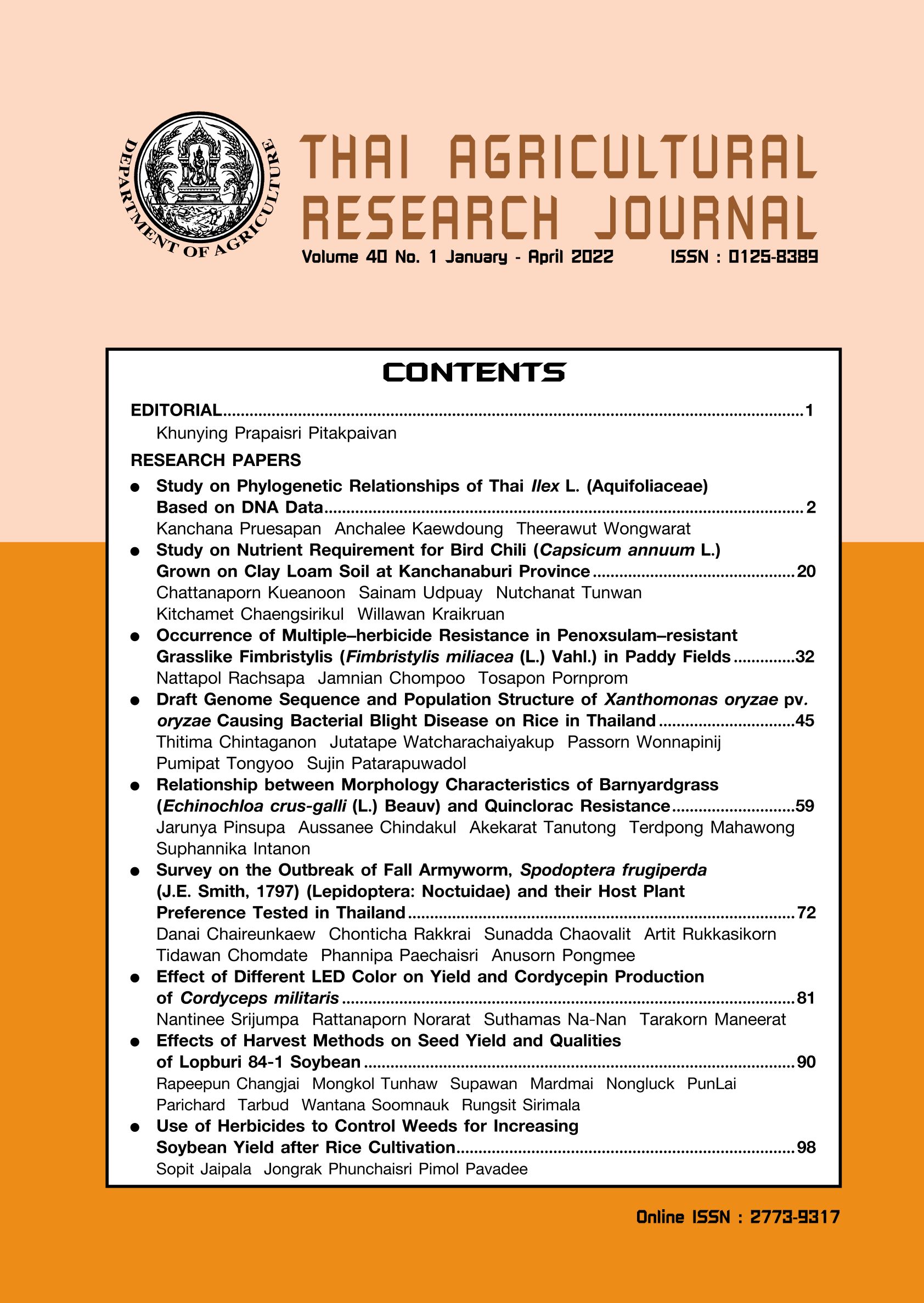Survey on the Outbreak of Fall Armyworm, Spodoptera frugiperda (J.E. Smith, 1797) (Lepidoptera: Noctuidae) and their Host Plant Preference Tested in Thailand
DOI:
https://doi.org/10.14456/thaidoa-agres.2022.6Keywords:
survey, host range, fall armyworm, Spodoptera frugiperda, host preferenceAbstract
Fall armyworm (FAW), Spodoptera frugiperda (J.E. Smith, 1797) is a serious pest of global importance. First outbreak in Thailand was reported at the end of 2018.The information from host plant preference study can be used in FAW control measure. Results of survey on the outbreaks of FAW in Thailand during December 2018 - December 2019 showed that their outbreaks occurred in all maize plantation areas. Testing on plant preference of 28 food crops in the laboratory of Plant Quarantine Research Group during May 2019 to October 2020 found that maize, sorghum, sunn hemp, ginger, peanut and culantro were host plants that FAW could complete 2 rounds of its life cycle. Study on the preference for oviposition of FAW found that they could lay their eggs on ginger, napier grass, rice, sorghum, sugarcane, bitter gourd, cassava, chili, cucumber, culantro, peanuts, sunn hemp and maize. The highest number of egg clusters were found on Maize. All of the above mentioned economic crops are at risk of being attacked by FAW.
References
CABI. 2019. Spodoptera frugiperda (fallarmyworm). CAB International. CABI is a registered EU trademark. Available at: https://www. cabi.org/isc/datasheet/29810. Accessed: January 20, 2019.
FAO. 2018a. Briefing note on fall armyworm (FAW) in Africa. FAO, Rome, Italy. Available at: https://www.fao.org/3/a-bt415e.pdf. Accessed: January 20, 2019.
FAO. 2018b. FAW GUIDANCE NOTE 3. FAO, Rome, Italy. Available at: https://www.fao.org/3/ i8322en/I8322EN.pdf. Accessed: January 20, 2019.
FAO. 2018c. ISPM 6. Surveillance. FAO, Rome, Italy. Available at: https://www.fao.org/ Documentscarden/c/7985f320-a606-47f9- 9f0b-9dfa5a2e1622/. Accessed: January 20, 2019.
Firake, D.M. and G.T. Behere. 2020. Bioecological attributes and physiological indices of invasive fall armyworm, Spodoptera frugiperda (J.E. Smith) infesting ginger (Zingiber officinale Roscoe) plants in India. J. Crop Prot. 137: 105233.
HE Li-mei, Wang Teng-li, Chen Yu-chao, GE Shi-shuai, Kris A. G. Wyckhuys and WU Kong-ming. 2021. Larval diet affects development and reproduction of East Asian strain of the fall armyworm, Spodoptera frugiperda. J. Integr. Agric. 20(3): 736–744.
Maruthadurai, R.and R. Ramesh.2020. Occurrence, damage pattern and biology of fall armyworm, Spodoptera frugiperda (J.E. smith) (Lepidoptera: Noctuidae) on fodder crops and green amaranth in Goa, India. Phytoparasitica. 48(1):15–23.
OEPP/EPPO. 2015. PM 7/124 Spodoptera littoralis, Spodoptera litura, Spodoptera frugiperda, Spodoptera eridania. Bulletin OEPP/EPPO Bulletin. 45(3): 410 – 444.
Passoa, S. 1991. Color identification of economically important Spodoptera larvae in Honduras (Lepidoptera: Noctuidae). Insecta. Mundi. 414. Available at: https:// digitalcommons.unl.edu/cgi/viewcontent. cgi?article=1413&context=insectamudi. Accessed: January 25, 2019.
Downloads
Published
How to Cite
Issue
Section
License
Copyright (c) 2022 Thai Agricultural Research Journal

This work is licensed under a Creative Commons Attribution-NonCommercial-NoDerivatives 4.0 International License.
Thai Agricultural Research Journal



